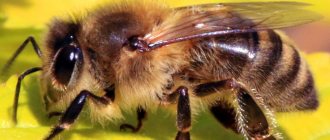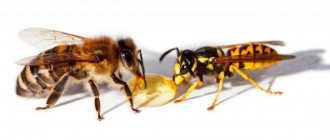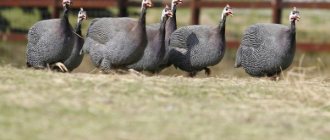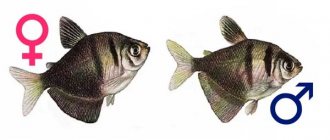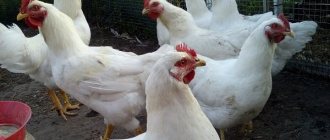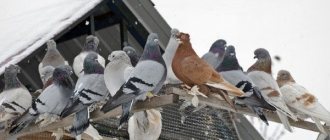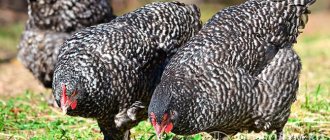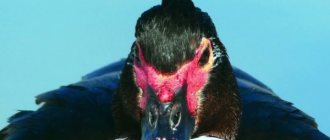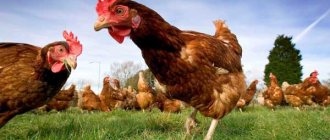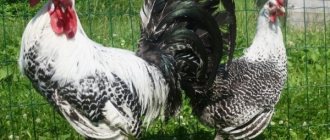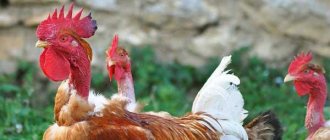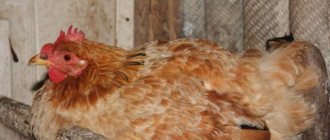Guinea fowl is similar in appearance to an ordinary chicken. This similarity is not accidental because these two species of birds, although distant, are relatives.
The body and legs of guinea fowl are medium-sized, the neck is long with sparse plumage. There are small growths on the crown of the head, covered with feathers.
Guinea fowl are one of the most beautiful birds: their bright colors outshine such shortcomings as a bare neck and short tail. Each type of guinea fowl is beautiful in its own way: for example, the body of an ordinary guinea fowl is covered with patterned feathers, which are covered with pearl circles, and those who have seen a vulture guinea fowl are simply delighted with its colorful coloring.
Simply stunningly beautiful plumage
Features of keeping guinea fowl with chickens
Guinea fowl is an amazing bird that can please not only with its high aesthetic qualities, but also with the excellent taste of meat and good egg production. However, many breeders do not risk breeding it, fearing that the bird needs special conditions, special maintenance and nutrition. In fact, this is far from reality: “royal” birds are unpretentious in care, have excellent immunity and good health, and can also exist in the same territory as traditional chickens.
Expert advice
The guinea fowl is an unusual bird; you rarely see it on a farmstead, but it eats for the most part, like chickens that are familiar to everyone. Below are tips for feeding guinea fowl that will allow you to regulate the diet and make it most effective so that the guinea fowl grows and develops as quickly as possible.
Newborn guinea fowl need feeding within a couple of hours
- Newborn guinea fowl need feeding within a couple of hours. The longer they go without food, the worse it gets, so you need to be prepared well in advance for their birthday.
- Little guinea fowl are always given only fresh food. The reason is that they simply refuse to eat sour, spoiled food. But, in addition, it is very harmful and can cause diarrhea, and then the death of the bird.
- Instead of shells, breeders often give crushed egg shells. In small quantities it is not harmful, but with frequent feeding, guinea fowls become aggressive, and cannibalism may even occur.
Is it possible to keep guinea fowl and chickens together?
Since guinea fowl belong to the order Galliformes, they get along well in the same poultry house with chickens. Nevertheless, each of the birds has its own characteristics, which should be taken into account when cohabiting.
What is the advantage
According to many poultry farmers, keeping chickens and “royal birds” in the same room is quite simple and profitable.
Such cohabitation has a number of key advantages:
- Same diet. If chickens and guinea fowl are raised to produce good, high-quality meat, then they need an almost identical diet: grains, wet mash, vegetables, herbs, complexes of vitamins and minerals. The same menu will allow breeders not to spend a lot of time and effort on feeding the birds.
- Similar conditions of detention. The conditions for keeping birds are quite simple: they sit together on perches, use the same nests for hatching eggs, need cleanliness, comfortable indoor air temperature, and normal humidity. To raise them in a chicken coop, you should provide good lighting and heating, and keep the litter dry and clean.
- Hatching eggs is one of the main advantages of living together between “royal birds” and chickens. The fact is that the former do not have a well-developed maternal instinct, so farmers often place their eggs under a brood hen, which copes well with the responsibilities assigned to it.
- As for the relationship between bird species, in general they get along well with each other . Sometimes roosters can show aggression towards their “relatives” and enter into conflicts. To minimize this behavior, it is recommended to keep birds in the same house from childhood.
Flaws
Cohabitation of chickens and guinea fowls in the same territory also has its disadvantages.
- Freedom . As you know, the guinea fowl is a very freedom-loving bird; its comfortable development requires space and walking. Birds do not accept cramped conditions and cage housing and need a fairly large space, while chickens can live in cages or small closed poultry houses.
- Reproduction . The same applies to the process of reproduction. Chickens can perfectly live in a cramped house to raise young animals, while guinea fowls need an aviary or a walk.
- Possibility of mating . Roosters can cover not only female hens, but also guinea fowls, which will cause the appearance of hybrids - birds that look similar to the “royal individuals”, but with the plumage of a chicken.
agronomu.com
Feeding
The diet is made up of dry grain mixtures, food waste, greens, mineral supplements or industrial feed. Grain mixtures are made from corn, barley, wheat, millet, and oats. The daily norm for an adult is 200 g. If the content is cellular, then meat and bone and grass meal are added to the menu. The daily dose is divided into 4 doses.
If guinea fowls are walking, then 3 meals a day is enough, since they find some of the food for themselves. Gravel is poured into one of the feeders. To replenish protein reserves, give a wet whey mash.
Chicks are given 15-35 g of food until the 10th day, while boiled eggs, cottage cheese, and fresh herbs remain the main ingredients in the diet. Until 30 days of age, they use special feed, increasing the norm after 10 days to 40-75 g. To strengthen the immune system, grain is sprouted.
A little about the history of the species
The guinea fowl is native to Africa, where many of its varieties lived. In ancient Rome, one of the species was domesticated, but with the collapse of the Roman Empire, it disappeared as a poultry. The guinea fowl came to Europe for the second time thanks to Portuguese sailors during the great geographical discoveries. Then it was kept as a curiosity among noble nobles; the meat was served at feasts as an exotic delicacy. They were also brought to Central Russia in the 18th century for entertainment, but the bird easily took root in Moscow and gradually became domesticated.
What to feed the birds?
The farmer should pay special attention to the diet of guinea fowl. Winter and summer feeding differ in many ways
In addition, the menu of birds bred for the parent flock and for fattening differs.
In summer, birds are able to obtain food on their own. They take great pleasure in eating the grass that grows in the walking area, pecking at bugs, and hunting small rodents. Wild lizards and the Colorado potato beetle, which can be collected in the garden, are considered an exceptional delicacy for them. In winter, guinea fowl mainly feed on grain crops, but one should not forget about greens.
If a farmer can independently figure out winter and summer feeding methods, then in the spring months the guinea fowl breeder should be extremely careful. Just in the spring, intensive egg laying occurs. To avoid problems, laying hens need to eat properly. As an example, it is proposed to consider the spring nutrition menu for laying guinea fowl.
| Products | Quantity |
| Oats | 20 g |
| Ground barley grains | 20 g |
| Millet | 10 g |
| Ground corn kernels | 20 g |
| Meat and bone meal | 20 g |
| Dry fish waste | 20 g |
| Raw carrots, finely grated | 20 g |
| Hay | 15 g |
| Feed yeast | 6 g |
| Fish fat | 3 g |
| Crushed shells | 5 g |
| Fresh nettle | 30 g |
| Bran | 20 g |
Of the entire list, the most important component of the spring diet is pine needles, which contain vitamin A, which promotes the normal development of guinea fowl. At the end of winter, almost before the onset of spring warmth and a change in diet, guinea fowls need to start giving vitamin supplements. After the guinea fowl's productive period ends, the grain composition of the bird's diet should be reduced. If this is not done, the birds begin to get fat. And it is very difficult for them to get rid of excess weight. Due to excess body weight, egg production, the percentage of fertilization and subsequent hatching of chicks decrease.
Guinea fowls need to be fed 3 times a day according to a pre-planned schedule, so that they will walk near the pen and will not try to escape. Basically, farmers give the genafal breakfast at 6 a.m., lunch at 12 p.m., and dinner at 4 p.m. If necessary, the proposed schedule can be shifted by one, maximum two hours.
Characteristics and features of the species
The plumage color of the guinea fowl can be gray speckled, cream and white. The body of this chicken is oval, the back is convex, the sternum is pointed in roosters, fleshy in hens. Males and females are not very different in appearance, but they cannot be confused. Males have a much larger head than females, and a hen's nose is also not as big as a rooster's. The hen holds her head straight, and the rooster puts it forward.
By nature, guinea fowl are shy, unlike domestic chickens, they get used to their owner and become nervous when strangers, cars, dogs and other large animals appear. Frightened, they behave noisily and cause quite a commotion in the poultry house.
A common question is whether guinea fowl can be kept with chickens. Yes, you can, because they treat other poultry calmly.
The weight of an adult is 1.7-3 kg, one hen produces from 90 to 150 eggs per year, the color of the eggs is yellowish, the shell is thick, so they are quite transportable and have a decent shelf life. The bird is ready for slaughter from the age of three months, when it has gained more than a kilogram in weight. The orientation of guinea fowl is most likely meat due to the excellent taste of the meat and the meatiness of the carcass.
For breeding, 5 - 6 hens are left per rooster; fertilization occurs on a walk, then the presence of a male is not required. It is possible to hatch guinea fowl in an incubator.
Description of the breed
Guinea fowl are close relatives of domestic chickens, turkeys and quails.
Their homeland is North Africa, but they feel great in various regions of our country and Europe. Guinea fowl were domesticated later than all domestic birds, so they largely retained the habits of their wild ancestors. Birds live in flocks and fly well. In appearance, the “African chicken” looks more like a turkey. As you can see in the photo, she has a large, almost horizontal body with a long neck and high legs. The plumage is dense, the color depends on the breed. The most common guinea fowl, close to the wild species, are speckled, dark gray in color, the size of a domestic chicken and weighing about 1.5 kg. The long neck in the area where it connects with the head is almost not feathered, but is covered with leathery growths. The cover in this area is bluish, and the head itself sometimes has a reddish collar.
A little history
The beautiful name “guinea fowl,” as philologists say, comes from the word “cesar,” that is, ruler, patron, king. People associate it with the legend of the origin of birds. According to its Greek plot, guinea fowl are the sisters of a certain Meleager, the son of King Oineus. As a result of the wrath of the gods, Meleager died, and his sisters turned into spotted birds. Guinea fowl became known in the scientific world in 1766, when they were first described by Carl Linnaeus under the name Numidameleagris.
Who guinea fowl are and what kind of bird they are has been known in our country since time immemorial. There is historical information that “overseas chickens” were presented to Ivan the Terrible as a gift. At his order, mass breeding of this bird began to be practiced. Over the next hundreds of years, guinea fowl were raised in home gardens along with turkeys and chickens. During the Soviet years, Russia even used industrial guinea fowl farming, but it was later forgotten as an unpromising and expensive business.
What attracts guinea fowl?
The answer to this question is simple - guinea fowl are bred for high-quality dietary meat. It has a special taste, reminiscent of game. Fans note the resemblance to pheasant and partridge. According to biological indicators, guinea fowl is very useful: 100 grams of product contains up to 27% protein. However, the carcass contains less fat and water than domestic chicken, so the meat is quite tough and requires special preparation.
Along with meat, they are also valued. They have a bright, rich taste due to denser protein and concentrated yolk. Guinea fowl eggs are similar in size to chicken eggs, but their vitamin composition is two to three times greater. In addition, thanks to the dense and durable shell, the eggs of “African” chickens have a long shelf life. At room temperature, products do not lose their biological properties for two months. Guinea fowl eggs can be stored in the refrigerator for up to a year.
“Royal” birds attract farmers due to their unpretentiousness in maintenance. Despite their origins, they adapt well to cold climates and can breed in captivity. In summer, it is useful to release them into the garden or home garden. Unlike chickens, they do not rummage in the ground or dig up plants, but they happily eat harmful insects and slugs. This is the only economic bird that helps fight the Colorado potato beetle.
Indicators and egg production
The egg production of guinea fowl is less than that of chickens. Females lay eggs only during the warm period of the year - from May to October - and produce about 90 eggs per season. Some improved and selected breeds lay up to 130-150 eggs per season. In terms of quality and productivity, guinea fowl meat is superior to chicken. It contains more healthy protein (20-23%) and little fat (no more than 7.5%). The yield of pure products is high – up to 85%.
Due to the special structure of muscle tissue and fibers, as well as the low content of subcutaneous fat, guinea fowl meat has an unattractive appearance: dry and with a blue tint. This is especially true for representatives of dark color. Beginners prefer buying white guinea fowl.
Breeding guinea fowl at home
Breeding guinea fowl is not difficult, no special structures or devices are required, and a separate chicken coop is not needed. If birds are raised for meat, large enclosure sizes are not needed; in a small space they gain weight faster, but close quarters have a negative effect on egg production.
No need for a big chicken coop
This bird is quite omnivorous; it happily eats both plant foods and various insects and their larvae. Guinea fowl can be used to destroy pests in gardens; they will not harm the plantings because they do not dig the ground like domestic chickens, but simply peck beetles and their larvae from the bush.
On a note! If you give guinea fowls free range and at the same time strictly adhere to the feeding regime, they themselves will come to the feeders at the right time. But you should not keep birds grazing freely for a long time; as a result, they can become weaned from their owner and go wild.
Guinea fowl can fly; flying over a fence is not a problem for them; to prevent such freedom, you have to resort to clipping the wings.
Diet choice
When choosing a bird’s diet, keep in mind that it must be correct and balanced
But it is also important to take into account the age of the birds and some of their features. Give individuals more protein food
Add more legumes to their diet. Birds also love insects, but they can get them themselves.
Stern
It is worth considering that if a breeder decides to get guinea fowl, then you need to understand that the birds require special feed. Although birds are unpretentious, they still need a balanced diet. The following should be used as food:
- cereal porridge;
- boiled vegetables;
- feed;
- green food (tops, chopped grass).
Sometimes add fishmeal to the porridge (although guinea fowl do not like such food).
Feeding guinea fowl chicks
Feeding chicks is exactly the same as feeding chicks
It is only important to monitor the quality of the food, as the chicks can get sick due to low-quality food. They switch to adult complementary foods quickly
Peculiarities
Guinea fowl chicken requires a balanced feed. The diet should include boiled eggs, freshly baked bread dipped in milk.
Grind the food in advance and place it in the feeders, do not forget to add drinking water.
Important! It is worth noting that young animals must be kept in a warm and clean place. It's also best to keep them away from the broody hen, as she won't protect them from the cold and the chicks may get sick and die.
Rules
There are no specific rules for the diet of chicks. The main thing is to carefully consider the choice of food.
There is one condition. If young animals are kept on pasture, then they need to be fed 3 times a day, because they can get food themselves.
If they are bred indoors, then very small chicks need to be fed at least 12 times a day, later the feeding regime decreases.
Features of feeding day-old chicks
As soon as the guinea fowl chick hatches, it needs to be given a crushed boiled egg with millet. Young animals eat little, but often.
Make sure that the chicks do not eat old food; they should only consume fresh food. Otherwise, the chicks may get poisoned and die.
Is it possible to keep them together?
Keeping these birds together is quite possible. The nature of the birds is somewhat different, but they can get along with each other. To achieve this, the easiest way is to raise chicks together. Adults are removed gradually, starting with the placement of several guinea fowl in the chicken coop. In case of aggression on the part of any chicken or rooster, the instigator is removed.
Why know the difference?
Knowing the sex of guinea fowl will help you competently organize your existing tribe. For effective breeding, 5 guinea fowls are needed per male, i.e. for a female flock of 20 birds, 4 males will be needed, so it is advisable to determine the gender before purchasing.
Of course, in poultry farming, females that produce eggs are considered more valuable, thereby ensuring the birth of a new brood. So the process goes in circles, bringing profit to the business owner.
In addition, being able to differentiate based on gender, you can regulate the livestock: excess roosters and unproductive hens can be slaughtered.
Pros and cons of this approach
- The main advantages of cohabitation include the following factors:
- identical feeding, which saves the breeder time and effort;
- similar requirements for the premises make it possible to avoid the construction of additional space;
- Since the maternal instinct of guinea fowl is reduced, hens are excellent for incubating their eggs.
- Certain disadvantages of shared content also exist:
- guinea fowl require more free space than chickens;
- a larger enclosure is also necessary for breeding;
- in case of conflicts, the egg production of chickens decreases;
- the possibility of crossing and the appearance of sterile hybrids.
It would be most optimal to keep them together with meat breeds of chickens, since the egg production periods of these species do not coincide.
Diseases
Diseases that vulture guinea fowl may suffer from:
- Infectious : trichomoniasis, pasteurellosis, pullorosis.
- Invasive : helminths, fleas.
- Non-contagious : dyspepsia, omphalitis, gout.
The main signs of trichomoniasis are diarrhea, foamy stools, loss of appetite and lethargy. Pasteurellosis by lethargy, increased temperature of the mucous membranes, diarrhea mixed with blood and mucous discharge from the nose. Pullorosis causes white stool, loss of coordination, and immobility.
All infectious diseases are treated only in the initial stages with broad-spectrum antibiotics prescribed by a doctor. Sick birds are isolated and, if treatment is ineffective, they are slaughtered.
Helminths provoke exhaustion and indigestion. Fleas cause great discomfort, reducing egg production and fatness. They use anthelmintic drugs and ash baths (boxes with sand and ash).
Symptoms of dyspepsia are diarrhea with mucus and foam, exhaustion, and immobility. For treatment, use a 0.2% solution of copper sulfate and a 0.03% solution of baking soda. Omphalitis is suppuration of the umbilical wound in chicks. The wound is lubricated with antibiotic ointment, and fortified food is administered. Gout leads to joint pain, immobility and exhaustion. Vitamins, herbs and bicarbonate of soda are added to the food.
All types of diseases are the result of improper care and poor nutrition. To prevent disease, you need to avoid dampness, dirt and humidity. Birds must have access to clean water, adequate space and balanced food.
- Parasites
- Infectious
- Other
Worms (helminths)
Roundworms that cause various diseases and, as a result, serious disorders in the body of birds
Read
Pere-eaters
How to deal with them using folk methods? How can I prevent parasites from appearing again?
Read
Mite
Diseases caused by the parasite. Symptoms, treatment, recommendations for prevention
Read
Newcastle disease (pseudoplague)
What is it and how to avoid infection? Main characteristics of the disease
Read
Pullorosis
Description of the disease, symptoms, treatment, preventive measures
Read
Aspergillosis
An infectious disease that affects the respiratory organs and leads to the death of the bird
Read
Psittacosis
Disease with severe respiratory disorders
Read
Salmonellosis
Symptoms of acute and permanent forms of the disease, treatment and prevention
Read
Colibacillosis
How to identify the source of the disease, how to cure a sick bird and immediately take preventive measures?
Read
Smallpox
Causes, symptoms of various forms, preventive measures and treatment methods
Read
Pecking
How does behavior disorder manifest itself, why is pecking dangerous and how to eliminate it?
Read
Rickets
A chronic disease characterized by impaired calcium-phosphorus metabolism
Read
Inflammation of the oviduct (salpingitis)
An inflammatory disease that can be effectively treated in the early stages. How to cure and restore egg laying?
Read
Features of Shared Content
The basic conditions for keeping and caring for these birds are identical. Co-location allows you not to think about demarcating the premises and creating separate paddocks.
Organization of the premises
For general living, birds need a spacious room.
The requirements for floor materials, bedding and perches are the same as for a conventional chicken coop. The main task is to provide protection from rodents and avoid dampness. Both types of birds sit on perches, so their number should be sufficient for the entire flock. On average, 6 birds can settle on 1 meter of perch.
Nutrition rules
The birds' diet consists of the same grain mixtures, as well as herbs, vegetables and various additives. Both species of birds eat 2-3 times a day; if they are free-ranging, you can feed them only in the evening. Guinea fowl chicks eat the same things as chickens, but have a much larger appetite. It is necessary to ensure that they do not completely eat the chicken feed.
How to make a perch
When making a perch for guinea fowl, proceed from the following dimensions. The bars should be installed parallel at a distance of 36 centimeters, the optimal section of the bar is 4 by 2 centimeters. The lower beam must be installed at a height of forty centimeters from the floors, and the upper one about sixty. The length of the perch should be calculated based on the ratio of one meter per six birds.
Arrangement of perches
Is it possible to distinguish in young animals
Having decided to get guinea fowl, many are interested in at what age the sex of the bird can be recognized. Experienced producers claim that secondary sexual characteristics appear only at 5–6 months. In chicks, it is almost impossible to visually distinguish between a boy and a girl.
Those who have been practicing poultry breeding for a long time can find out the sex of newborn chickens.
The surest way is to check the genitals. In cockerels they are better developed and resemble a small tubercle. Chickens do not have any outgrowths.
